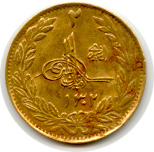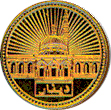This seminar was co organised by Dinar-Dirham Foundation,
Indonesia and attended by various sections of the international community
- diplomats, financiers, business community, academics and religious
bodies. The seminar was successful in emphasising the importance of
returning to the Islamic bimetallic currency of gold and silver, in
place of usurious paper money. Calls congratulating the organisers came
pouring in the next day, as well as reports in the national papers.
Seven speakers dwelt considerably on the subject. Dr Hakimi expounded
on the views of European thinkers like Goethe, Wagner, Ezra Pound and
Nietzche, all of whom criticised paper money and its usurious nature.
He then mentioned Shaykh Muhammad 'Illish, an expert on fiqh at Al-Azhar
University who gave a fatwa that included zakat is not payable for paper
money. However, Syeikh Muhammad Abduh made fatwa making halal the interest
from postal savings. This signals the start of islamisation of interest
and banking. His student, Rashid Redha, continued this thesis in his
writings.
As a Muslim country, gold coins had been in use in Malaysia,
for example the Kijang mas. This is the gold coin from the Kelantan
Sultanate during the rule of the Malay queen, Che Siti Wan Kembang in
1850. It is notable that power of the Muslims degenerated with the acceptance
of a non gold based economy. For example, the fall of the Othmanli Caliphate
in Turkey (1923) was partly due to the removal of gold (Dinar) and silver
(Dirham) from circulation. The Caliphate's unfavorable trade balance
resulted in an outflow of gold, while European states demanded more
favorable trade treaties and were guilty of blatantly abusing them.
Dr Hakimi continued with Malaysia's experience since
independence. This can be categorised into three phases: beginning with
the establishment of a central bank during the period of just developing
the country. The second phase saw the process of Islamisation when many
financial institutions were "islamised". This included the establishment
of Islamic banks and banking, Tabung Haji and Islamic Insurance. However,
during this phase the prime minister of Malaysia, Dr Mahathir announced
that the current monetary system based on paper money and cheques is
not within the Islamic system. Around the same time, Shaykh Abdulqadir
as-Sufi also brought to light the usurious nature of paper money.
The third and current phase is the move towards gold
based economy, spurred by the 1997 Asia Economic Crisis. Dr Mahathir
declared at The Annual Seminar of The World Bank in Hong Kong that currency
speculation should be made illegal since paper money in itself has no
intrinsic value. As a response to the economic crisis, Malaysia withdrew
RM 500 and RM 1000 notes from circulation. The Government then imposed
currency control, pegging the ringgit to the US dollar. At the same
time, any form of intervention by the IMF was rejected. In 1999, Dr
Mahathir reiterated that paper money has no value. The value registered
on a piece of paper only has value when it is endorsed by the government.
The first exposition of the dinar (gold coin) and dirham
(silver coin) was held in Universiti Sains Malaysia in 1998, at the
3rd International Islamic Political Economy Conference (IIPEC), officiated
by the then Minister of Finance, Tun Daim Zainuddin. In 2000, e-dinar
Ltd. was established as an off-shore facility in Labuan. The e dinar
was then launched at the 4th IIPEC, jointly organised by ISNET-USM and
officiated by the Deputy Prime Minister of Malaysia. The e-dinar Ltd.
team also had a meeting with the Prime Minister.
In December 2000, The Royal Mint of Malaysia was awarded
the rights to mint Malaysian gold coins, named the Kijang Emas. The
issue of the Kijang Emas gold coin was launched by Dr Mahathir early
in 2001. At the Al Baraka Symposium in 2001, Dr Mahathir declared that
the Islamic Gold Dinar be used as the currency for trade and national
reserves among OIC countries. He confirmed that the dinar is not paper
but must be in gold.
In July 2001 Shaykh Abdalqadir as-Sufi, accompanied
by the CEO of e-dinar Ltd. Rais Umar Vadillo, paid a courtesy call on
the Prime Minister, Datuk Seri Dr Mahathir. In this meeting, Dr Mahathir
expressed his intention to hold a seminar to discuss the introduction
of the gold dinar as a world currency and determine its usage and the
dimension of its applications. Shaykh Abdalqadir as-Sufi was conferred
the honorary doctorate of letters by USM in August 2001. As guest speaker
of a USM public lecture held two days earlier, Shaykh Abdalqadir as-Sufi
spoke on the Restoration of Fiscal Islam, urging for the reinstatement
of the gold dinar and silver dirham in the monetary system. In 2002,
Rais Umar Vadillo briefed Dr Mahathir on further developments of the
Islamic dinar.
Dr Hakimi also enlightened the seminar audience on efforts
relating to establishing the use of this bimetallic currency outside
Malaysia, as well as the views of various experts on this matter. The
first gold dinar and silver dirham was minted by Islamic Mint Spain
in 1992. In 1996, e-dinar Ltd. established the first web site on gold
and silver economy. Indonesia suffered greatly under the Asia Economic
crisis. As a result, in 1998 UPP Logam Mulia minted gold coins named
Koin Ongkos Naik Haji, with the specific purpose of savings for Hajj.
Thus the people can guarantee the value of their savings against massive
fluctuations in the Indonesia Rupiah. This was followed by the minting
of the gold dinar and silver dirham for Islamic Mint Indonesia.
In 1993, Kurtzman wrote in his book The Death of Money
that paper money has become a twisted abstraction when President Nixon
removed the gold backing to the US dollar. Although paper money is still
a promissary note, but there are questions that arise - namely "what
is to be paid?" and "who is to receive this payment?". In 1998 Dr Nasir
Farid Wasil, Mufti of Egypt urged the reestablishment of Islamic economy
based on gold and silver, in place of the US dollar.
The next speaker, Dr Zuhaimy presented a paper titled
Towards Establishing A Stable Currency in the Region. Dr Zuhaimy explained
the usurious nature of paper money - existing as promissary note or
as fiat money: that issued by governments. This allows banks to produce
money out of nothing, so paper money is actually debt money. The manipulability
of the value of paper money makes it a very unstable currency. He then
showed that economics is not neutral since its presumptions opposes
Allah's injunction. Economics has forbidden trade and permitted riba,
but Allah has permitted trade and forbidden riba. There is thus a need
to replace speculative economy with trade (real economy).
Dr Zuhaimy then talked about the national debt - that
it can never be repaid. A nation is forced to borrow to justify taxation
- the capital borrowed is used to finance projects, for which taxes
are charged to provide the means to repay the debt. The interest imposed
on the national debt causes it to grow exponentially, yet payments are
made regularly. In this way, payments never catch up with the growing
national debt. Nations just continue paying!
The speaker continued with a description of the Islamisation
process, beginning with the Islamisation of knowledge. Yet knowledge
cannot be Islamised. All knowledge belongs to Allah. The final agenda
in the Islamisation process is the Islamisation of financial institutions.
The methodology of Islamisation involves the abandoning of the original
practice based on amal and reverting to text then developing principles
and procedures. Having lost the amal, Islamisation of practices (amal)
alien to Islam becomes the norm. Thus, for example the Islamisation
of financial institutions in effect becomes an attempt at icing the
cake, while overlooking to question the basis of such systems.
It is by this method that modern Islamic scholars have
proposed the creation of Islamic central banks to issue currency or
paper money backed by gold. This is effectively the gold standard. However
throughout history gold was used as money, then papers represented gold
and then later, papers backed by gold were used as money. Today, money
is pure paper not backed by any specie of any kind. And now, money is
in the form of computer signals. The value of money today can never
be guaranteed, and remains unstable.
Dr Zuhaimy proposes that the way to a stable currency
in the region is by adopting the Islamic Gold Dinar (IGD) and the Islamic
Silver Dirham (ISD) and establish real economy. It must be gradual,
beginning with co existence of the banking system and the bimetallic
currency of gold and silver. The ultimate goal of the IGD is to eliminate
usury. The people should be allowed to choose the IGD as an alternative.
The IGD and IGD-payment systems should develop in accordance to the
general policy of promoting Islamic Trading, thus avoiding usury.
The third speaker, Dr Abdalhamid Evans who represented
Rais Umar Ibrahim Vadillo presented a paper on The Core Mechanism of
real economy. The elements of real economy are markets, qirad, trading,
awqaf, guilds and the IGD. In contrast, speculative economy has as its
elements - banking, interest, stock exchanges, financial instruments,
credit and paper money. In real economy, transactions involve the exchange
of goods and money, bound by contracts and conducted in a particular
place. The core mechanism of real economy has three components, namely
the market network, investment and the payment system.
The market network of suqs and e-suqs provides traders
with accessible open markets. Rent is not paid and the trader has no
exclusive right to a particular location in the market. Investment in
trading is by the contract of qirad and e-qirad, which circumvents the
conventional banking system. The payment system adopted in this real
economy is the dinar and e-dinar, the only universally stable currency.
Another speaker and lecturer in law at the Universiti
Sumatera Utara, Mr O.K. Saidin talked about the ownership that is attached
to money. Ownership does not follow paper money, either in time or distance.
On the other hand, such ownership remains with gold and silver. Gold
and silver still has value even after being melted down, or transported
to another country or kept for hundreds of years. One cannot claim the
value attached to paper money once it has turned to ashes, or for an
Indonesian Rupiah printed twenty years ago. A Rupiah will not be accepted
in Germany, yet a US dollar is accepted in Indonesia. So, the ownership
of paper money will follow only if it is from a particular country.
This is a form of control, invisible to many.
The seminar has gathered experts from various fields
and a complete picture of real economy, driven by the bimetallic currency
of the Islamic Gold Dinar and Islamic Silver Dirham was presented.
 THE GOLD DINAR RESEARCH GROUP
THE GOLD DINAR RESEARCH GROUP 